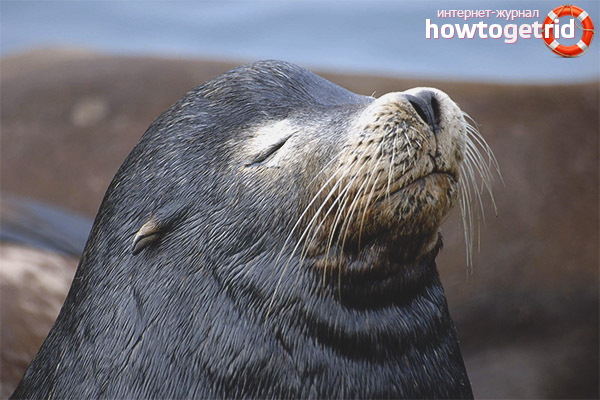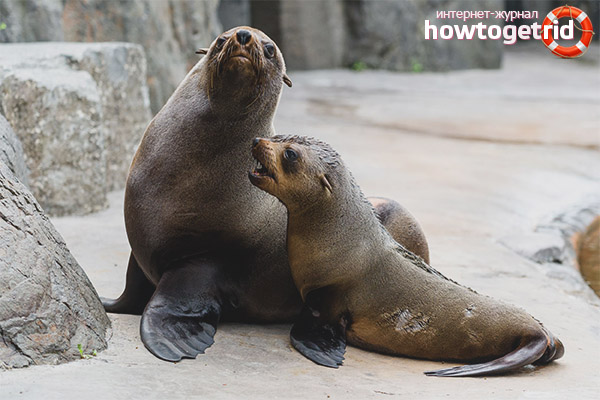The content of the article
Seals are often the heroes of funny video clips and funny photos. They attract attention not only by their behavior, but also by external data. These semi-aquatic inhabitants can stay outside the land for a long time and still feel great. Seals are quite common, so we will study all the features associated with them.
Description
- The presented animals are similar to sea lions and seals, of course, not in everything, but only partially. They have a typical corpus constitution, a peculiar temperament and a method of obtaining food. Even reproduction is partially the same, what can we say about the places of distribution. Even arrange rookeries joint, it does not bother anyone, there are no conflicts. For the first time described the fur seals in the 18th century.
- Colonies of mammals do not have such a number. Livestock can be several thousand and even more.Long since these individuals lived in the northern hemisphere, but gradually began to migrate. Previously, poachers caught the representatives of the family, so the population was declining every day. It is the fur that is distinguished for its high cost.
- Uncontrolled fishing has led to the fact that fur seals have become very small. Then adopted a law on their protection, the population gradually began to revive. Growth began in the 1960s. Poaching cannot be ruled out completely, although it is illegal.
- Catching cats can be legalized when it comes to their production for dolphinariums and other establishments of this type. Also so-called shows of fur seals are very popular in various countries of the world. On the island of Bering, which ranks among the Russian Federation, the capture takes place.
- Presented animals are large. Some individuals of male sex reach a length of 2 meters. With a body weight of 250 kg. Females grow to 1.5 meters with a weight of 80 kg. A distinctive feature of these animals from the sebaceous can be considered the fact that in cold water they are not warmed by fat at all, but by dense warm fur.
- Adipose tissue is slightly deeper. The fur coat in the upper part is insulated with wool pigmented with black. It is tough, monophonic. The final color depends on the particular animal, but darkened colors are most common.
- There are albinos, covered with light wool. However, this is considered a genetic disorder, therefore almost all cubs do not survive. If, nevertheless, the baby can survive, after a couple of months a molt is waiting for him. Light wool is replaced by gray, such and remains in the future.
Habitat
- This animal is not peculiar way of existence in one place. Constantly representatives wander, choosing a suitable area for food and reproduction. The mating season begins in special rookeries, where several thousand individuals congregate. These rookeries are constant, the seals come back here year after year.
- As a rule, for breeding, they choose sandy beaches with a small number of sloping stones. Typically, there are shallows in the habitat to make it comfortable to lie in the water. Mammals prefer to hide from the waves behind the reefs and stones.
- They also like to live among the algae. Cubs splash in water, learn to swim, hunt small fish. When the winter season comes, adult representatives of the pack go hunting in the sea. Hunting can take up to six months, for this period the seals are broken up in groups.
Species
There are many species, but we list the most famous.
- New Zealand. As the name implies, members of the family are in New Zealand. They also live in Australia and nearby territories. They are distinguished by a brownish body color, reaching 2.4 m in size. Weight varies between 160-180 kg.
- Galapagos. Today, representatives of this group are ranked as the smallest. They weigh about 65 kg. with a body length of about 1.5 m. Different brownish-gray color. The peculiarities include the fact that animals lead a sedentary life. They do not wander from one place to another. Most of their lives spend on land, eat fish and mollusks. Distributed in the Galapagos Islands.
- Cape This species is more common in South Africa.There are individuals near the Namib desert and are the only ones of their kind living in a similar area. They settle on the coastline, according to external data they do not differ from the rest of the seals. Painted dark, grow to 2.4 m.
- Subtropical. Medium-sized individuals growing up to 165 kg. maximum. The hull is extended to 2 m. Distributed in the southern part of the Atlantic coast, found in Amsterdam. They are considered long-livers because they are 28 years old or more. Males are painted on their backs dark gray or black, and females are light gray-white.
Breeding
- Seals reach sexual maturity at 3 years. However, they can fight for females and start mating only after the seventh year of life. By this time they are gaining the courage and strength to win the lady you like. Some seals mate for the first time only after ten years of life, because they can not discourage the female from itself.
- Individuals of female sex have much easier. They are at the rookery, look at the fights of the males and meekly surrender to the winner after the end of the skirmish.As for the duration of life, individuals of this family live 20-30 years.
- Around the end of springtime or the beginning of the summer season, the mating season begins. Fights are violent clashes, often leading to severe injuries and even death. Due to natural selection, nothing else remains.
- The rookery is becoming closer every day, so the territory is fairly divided. Pieces of land are allocated to each group. Then the male begins his demonstration performances, causing the opponent to fight. Around a strong cat is going to a harem of females.
- Females can not leave the group and the designated area without prior approval. Even if you like a male from another group, the lady is forced to sit and look at the leader of the pack. This is partly the reason for the abduction of female individuals. An alien male simply grabs it with his teeth and tries to pull him into his group.
- In this battle, only the female individual suffers. Her from one side to the other, until the males do serious injuries. When the division is over, pairing begins. After the birth of cubs, the mother nurses them for another 3-5 months.
There are many varieties of the represented family, which are common in the southern and northern hemispheres. However, these animals like cold climatic regions more. It is for this reason that they have such a body structure, designed for a long stay in cold water.
Video: fur seal (Arctocephalinae)













To send